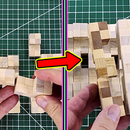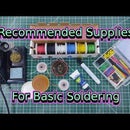Introduction: Make a Colorful Infinity Mirror
In my last instructable, I made an infinity mirror with white lights. This time I'm going to make one with colorful lights, using an LED strip with addressable LEDs. I'll be following a lot of the same steps from that last instructable, so I'm not going to go into much detail with those steps and focus more on what I'm doing different with this one. I recommend checking out my previous instructable to get more information on those steps. You can see that instructable here: Make a 2-Sided, Desktop Infinity Mirror
If you would like to see a video version of THIS instructable, you can see it here: https://youtu.be/T-jcIiV6ovI
Here is what I used for this project:
Tools
- Jig Saw
- Jig Saw Blade
- Drill
- 1/4" Brad Point Drill Bit
- 3/16" Drill Bit
- Tiny Drill Bit
- Tiny Screws
- Fender Washers
- Speed Square
- Wood Glue
- Soldering Iron
- Solder
- Hot Glue Gun
- Hot Glue Sticks
Parts
Step 1: Make the Frame
This infinity mirror is going to be bigger than my last. It's going to have 12 sides, and for each side I measured out 3 3/8 inches and cut them at a 15 degree angle. I sand the cut ends smooth then glue them together with wood glue. I only glue together 2 pieces at a time and let them set for half an hour before gluing each segment together.
Step 2: Attaching the LEDs
For this infinity mirror, I'm going to attach the LED strip differently than I did my last one. I cut the LED strip at 60 LEDs. I want there to be 5 LEDs on each side, so I put a mark in the middle of each side (1 11/16 inches). I start with the 3rd LED and attach it at the first middle mark. After that I count out 5 more LEDs and align that one to the next middle mark. I attach the LED strip to the frame at only that LED. I continue attaching each 5th LED to the middle mark of each side. The LED strip doesn't come into contact with most of the frame, so to make sure the LED strip doesn't come off I put hot glue between the strip and the frame in the gaps at the corners.
Step 3: Soldering on the Wires
Some addressable LED strips have 3 contact points and some have 4, mine has 3. They also have a first and a last LED. The first LED has arrows pointing away from it towards the second LED. This is where you want to solder the wires that attach to your controller. I lift up the first LED so that I can drill a hole in the frame to pass the wires through. I'm going to solder this 3 wire female connector to the LED strip. It will be able to connect directly to the controller that I have. I solder the white wire to ground, the red to 5 volt positive, and green to the middle data connection.
Step 4: Making the Mirrors
Next I prepared the mirrors for this infinity mirror. I didn't take pictures of me doing this, but it's the same process that I did in my last instructable, so I'll show those photos instead. I'm also going to only briefly describe the process here. If you would like to see it in more detail, check out my other instructable: (see steps 4 and 5)
Trace the frame onto the plexiglass, then cut it out. Remove one piece of the protective film from the plexiglass, then get that side wet with soapy water. Remove the protective film from your mirror tint, and attach the tint to the plexiglass. Use a smooth, firm piece of plastic to smooth out the bubbles and wrinkles. Then trim away the extra tint from around the mirror. I made 2 of these mirrors.
Step 5: Helpful Tip
You'll probably notice sometimes that I have the letter B written on the two frames. I did this for a good reason. When I drilled the holes in the next step, I didn't measure where I was putting them, so I needed a way to keep all the parts positioned correctly so that I wouldn't have to figure it out each time I needed to put them back together. It's harder to see, but that mark is also written on the 2 pieces of plexiglass.
Step 6: Prepare to Connect the Layers
For this infinity mirror, I'm going to put all of the parts together differently than I did last time. I'm still taking the same steps to make the holes in the plexiglass and frame, but with 6 holes instead of the 4 that I did last time. I also built an outer frame that will give the final project a better appearance. Next I get a 1/4 inch dowel and cut off 6 pieces, each 1 inch long that I'll use to hold all of the layers together. I drill two holes through the outer frame and insert one of the pieces of dowel into each of them. This will help keep both frames aligned while I drill the other holes. As I drill each hole I insert one of the pieces of dowels.
Step 7: Gluing the Dowels
I want to glue the dowels to the outer frame, but not the inner frame. As you can see, the dowels go through both frames right now, but they mess up the pattern on the outer frame. I push each of the dowels down below the surface of the outer frame, but not all of the way out. I put some glue into the hole, then I move and twist the dowel trying to get the glue to cover as much of the contacting surfaces as I can. But when it's done, I don't want the dowel to extend past the surface. When I get the dowel positioned where I want it, I clean up the excess wood glue. After I do this with all 6 dowels, I let the glue dry completely.
Step 8: Repairing the Damage
After the glue dried, I removed the inner frame and used wood filler to fill the outer part of the holes in the outer frame. The wood filler that I used is pink when it's first applied and turns tan when dried. I used extra so that I can sand it down to match the pattern of the frame. I gently sand down the dry wood filler until it is level and smooth with the surface of the frame. After I finished sanding all 6 spots, I added some extra filler to a few of them that I needed to touch up and did the same thing again. When I was satisfied with the results, I painted the frame.
Step 9: Making the Back Layer
Now I'm getting a piece of black foam board and trace out the inner frame onto it, then I cut it out. I align the frame with it and use the drill bit to mark where I need to put the holes for it. This piece of foam board is going to be the back layer of the infinity mirror.
Step 10: Mounting the Back Layer
I start putting the layers in place. I'm going to hold them all together with some screws and fender washers. The screws are going to go into the dowels, so I need to drill a pilot hole into each of them. After each of the holes are drilled I put the foam board on the back and screw it into place. Everything looks good, so now I take it back apart and remove the final layer of protective film from both pieces of plexiglass.
Step 11: Final Touches
Now there is just one thing left to do, and that is to give me a way to hang it on the wall. Once I get it all back together, I remove one of the screws from the back. I take a soda can tab and screw that onto the back. I bend it out slightly to make it easier to hang. Now it's time to test it. I connect my LED controller to the infinity mirror, then connect that to my 5 volt power supply and turn it on. Make sure you choose a controller and power supply that matches the voltage that your LED strip needs.
Step 12: And That's It!
Now that it's all working, I have it hanging on the wall next to my tv, but technically it's not completely finished yet. I have more plans with this infinity mirror, and the addressable LEDs will give me a lot of options for custom displays. If there are any tips or ideas that you have, feel free to leave a comment.













